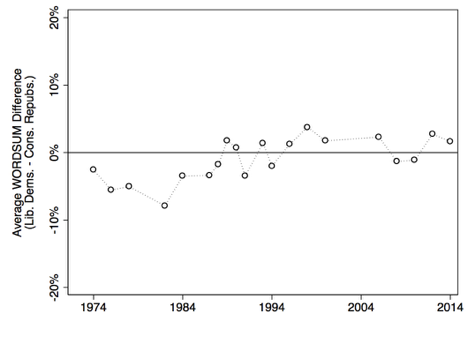
Political divisions in America today are highly personal. We get so deeply invested in our views that it can be hard to believe people on the other side don’t see things our way.
In the 2016 presidential campaign, for example, prominent left-leaning pundits and personalities described Trump voters as delusional and “near-imbeciles,” willing to embrace “bald-faced stupidity.” On certain right wing media outlets, we saw headlines like “Are Democrats Really This Stupid?” and President Trump himself referred to his predecessor and general-election opponent as “stupid” on several occasions, during the campaign.
While it may be tempting to dismiss those who disagree with us as unintelligent, most research on the subject suggests that this is simply not true. In surveys of the American public, several scholars have documented differences in IQ scores across party, ideological, and issue-based lines. However, these differences tend to be quite small.
Even so, calling one side less intelligent than the other is overly simplistic. Democrats tend to score slightly lower on intelligence tests than Republicans, but, liberals tend to score more highly than conservatives. Noah Carl argues that this may occur because intelligence boosts support for both liberal positions on social issues (like gay rights and abortion), and conservative positions on economic issues (like free trade and government regulation of the economy). As Gerhard Meisenberg demonstrates, intelligence has more to do with formulating opinions in the first place, rather than picking any particular side.
The figure below demonstrates how similar we really are, using data from the General Social Survey (GSS) from 1974 - 2014. The vertical axis corresponds differences in scores on a vocabulary test known as WORDSUM (which correlates highly with lengthier IQ tests). Dots represent the average difference between liberal Democrats and conservative Republicans, over time (see Note 1 for more information).

The results make two important points. First, neither side has tended to be more intelligent than the other over time. The difference between the two swings back and forth. Second, these differences are quite small, generally hovering around zero. More-formal statistical tests reveal that, on average, liberal Democrats hold less than a 1% advantage over conservative Republicans (See Notes 2 and 3).
Partisan name-calling may be common on Twitter, the news, and even in daily conversation. However, it is simply inaccurate to characterize those who disagree with us as “stupid” or “unintelligent.” While Democrats and Republicans may have different values, moral frameworks, and other psychological traits, our levels of intelligence are quite similar.
Notes
- The GSS data are weighted to known population benchmarks. N = 10,819.
- This difference is not significant at the p > 0.10 level, two tailed (N = 9,893). Results are based on an OLS regression model, controlling for three known predictors of WORDSUM: education, socio-economic status, and age.
- This pattern also holds in the American National Election Studies (ANES) data from 2016. There were no significant differences in mean WORDSUM scores between Trump voters (who averaged .71) and Clinton voters (who averaged .72).
Photo by Eric Constantineau, Flickr CC

